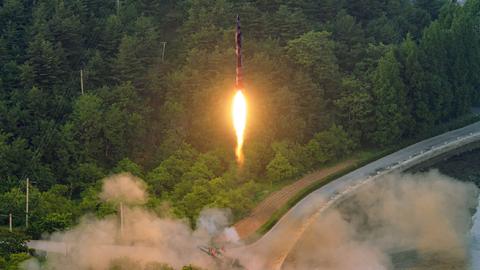North Korea’s murder of Otto Warmbier is yet another reminder that the United States needs a new approach to deal with the Pyongyang problem. Unfortunately, sanctions, threats, and diplomacy have failed to steer North Korea away from making America its primary nuclear target.
In his testimony to the House Armed Services Committee last week, U.S. Defense Secretary James Mattis accurately called North Korea a “most urgent and dangerous threat” to global security. Chairman of the Joint Chiefs of Staff General Joseph Dunford, speaking at the hearing, noted that “North Korea has been on a relentless path to field a nuclear-armed ICBM that can reach the United States.”
The sheer number and diversity of these recent tests have forced U.S. and South Korean planners to raise expectations of Pyongyang’s destructive capabilities. Keeping ahead of the North Korean threat requires addressing near-term gaps by building on recent achievements while investing in emerging technologies.
Though warning of the costs of having to fight “a war like nothing we have seen since 1953” if conflict broke out again on the Korean Peninsula, Mattis told the committee that the ground-based interceptors (GBIs) stationed in Alaska and California provide adequate protection despite North Korean and other missile threats: “It’s a worsening situation. . . . But we can buy the time right now.” These systems consist, first, of a multistage solid-fuel booster. It propels a “kill vehicle” that collides with a target in outer space, obliterating any warhead before it can even return to the atmosphere.
Matching the growing threat, the Pentagon has recently made ground-based mid-course defense exercises more demanding and operationally relevant. Last month, the Missile Defense Agency (MDA) conducted its first comprehensive live-fire test to simulate shielding the United States against a higher, longer, and faster flying target akin to a North Korean (or Iranian) ICBM.
Following the successful interception, the Pentagon’s test oversight body reversed an earlier assessment that the system had low reliability. The new appraisal concludes that the GBIs have a “demonstrated capability to defend the U.S. homeland from a small number of intermediate-range or intercontinental missile threats” — precisely the kind of threat Pyongyang presents — “with simple countermeasures.”
Even so, the potential of the existing interceptors is limited. They were hurriedly deployed as advanced prototypes more than a dozen years ago to hedge against potential rogue missile threats. Despite modest upgrades, such as redesigned thruster engines, these systems are still based on decades-old technology. Each kill vehicle has thousands of components produced and refurbished at various times and places. They beg for comprehensive modernization.
To overcome these limitations, the MDA is researching revolutionary technologies such as unmanned aerial vehicle-borne lasers, but near-term breakthroughs are improbable. Even the new 2025 for the proposed multi-object kill vehicle, which seeks to shoot down multiple targets in one flight, seems dangerously optimistic given all the problems with the rushed GBI deployments.
With North Korea likely to acquire nuclear-armed missiles capable of reaching American soil, developing more-reliable protection much sooner is imperative. My Hudson colleague Arthur Herman has thoughtfully laid out how a boost-phase intercept system employing unmanned aerial vehicles armed with conventional interceptor missiles could provide one near-term solution. Another important layer will be the redesigned kill vehicle (RKV), with improved homeland-defense interceptors, that the Pentagon aims to begin deploying and testing in the next few years.
The RKV will incorporate defense technologies that, unlike the original GBI components, have performed well for 20 years with shorter-range interceptors. In particular, the RKV will enable superior cybersecurity and control, enhanced communications between onboard sensors and other radars, and better discrimination between decoys and warheads. With a more reliable kill vehicle, the defender can take fewer shots at each target and have more interceptors available for any contingency.
The RKV’s simplified design features a standardized structure, open architecture, and fewer parts. The modularization would facilitate the construction, maintenance, and improvement of components, raising the GBI fleet to a higher uniform standard while reducing costs by encouraging competition among potential suppliers. The greater affordability derived from modernizing and building on successful investments would permit the more frequent live-fire tests and upgrades needed to stay ahead of emerging threats.
Smart missile-defense spending — staying ahead of threats through prudent investments in proven technologies — is the best path to a more secure future.



















